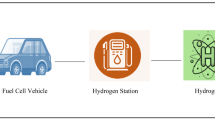Abstract
With life cycle assessment (LCA) methodology, a life cycle model of coal-based vehicle fuels (CBVFs) including coal-based dimethyl ether (CBDME) and coal-based diesel (CBD) is established. Their primary energy consumption (PEC) and global warming potential (GWP) from well to wheel including feedstock extraction, fuel production, fuel consumption in vehicle and energy transportation are calculated and compared. Results show that the life cycle PEC and GWP of CBD pathway are 1.17 and 1.34 times as CBDME pathway. Based on the above results, CBDME will become a choice with great potential to replace conventional petroleum-based diesel (CPBD) in China.
Similar content being viewed by others
References
Fleisch T, McCarthy C, Basu A, et al. A new clean diesel technology: Demonstration of ULEV emissions on a Navistar diesel engine fueled with dimethyl ether [J]. SAE Trans, 1995, 104(4): 42–53.
Society of Environmental Toxicology and Chemistry (SETAC). Guidelines for life cycle assessment: A code of practice [M]. Brussels: SETAC, 1993.
GB/T 19754-2005, Heavy hybrid electricity vehicle, experimental method of energy consumption [S].
Zhang L, Huang Z, Zhou X P, et al. Energy consumption simulation of urban bus fueled with dimethyl ether [J]. Automotive Engineering, 2007, 29: 71–74 (in Chinese).
National Bureau of Statistics of China. China statistical yearbook [R]. Beijing: China Statistics Press, 2004 (in Chinese).
Yang J X, Xu C, Wang R S. Methodology of life cycle assessment for product [M]. Beijing: Weather Press, 2002.
Liu W G, Yu X S. Power generation technology and potential analysis of coal bed methane in coal mine area in China [J]. Electric Power, 2004, 37: 17–20 (in Chinese).
Federal Energy Technology Center, U.S. Department of Energy. Baseline design/economics for advanced fischer-tropsch technology [Z]. Pittsburgh: Federal Energy Technology Center, U.S. Department of Energy, 1998.
Gerald N C, Sheldon J K, Samuel S. T. Simulation models and designs for advanced fischer-tropsch technology [C]//Coal Liquefaction and Gas Conversion Contractors Review Conference. Pittburgh: [s.n.], 1995: 269–282.
Zhang Z M, Men Z W. Technology of direct and indirect coal liquefaction to produce fuel oil [J]. Petroleum Refinery Engineering, 2003, 33: 58–60 (in Chinese).
Li D S. Analysis and evaluation on technology of oil making from coal [J]. Coal Chemical Industry, 2003, 30(1): 17–23 (in Chinese).
Author information
Authors and Affiliations
Corresponding author
Rights and permissions
About this article
Cite this article
Zhang, L., Huang, Z. Comparison of coal-based dimethyl ether and diesel as vehicle fuels from well to wheel in China. J. Shanghai Jiaotong Univ. (Sci.) 14, 210–214 (2009). https://doi.org/10.1007/s12204-009-0210-4
Received:
Published:
Issue Date:
DOI: https://doi.org/10.1007/s12204-009-0210-4
Key words
- coal-based vehicle fuel (CBVF)
- life cycle assessment (LCA)
- primary energy consumption (PEC)
- global warming potential (GWP)




